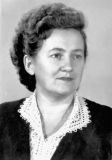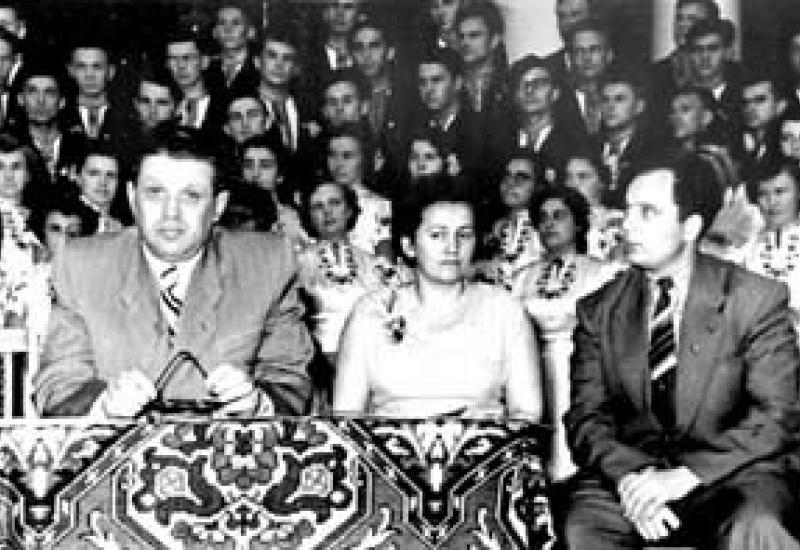Chapel of KPI is 60! It is a short time for the institution, but for the student choir it is a large period. Every five years its participants change (during this time 12 generations of students have changed!).
Everything began in such a way. M.I.Verykivskyy, professor of the conductorial department in Kyiv conservatory, sent Lida Padalko, excellent second year student, to KPI one of the largest universities in Kyiv as a concertmaster of the ensemble. Two months later, she headed this ensemble and soon converted it into a small choir.
"In the early postwar years, when Polytechnic Institute resumed its work, the students gathered in the evening at leisure in the red corners of hostels to sing, dance, have fun - Lydia Padalko wrote in her small booklet "Choir of Kiev Lenin Order of Polytechnic Institute" that was published in the publishing house "Art" 1951. - Party organization and trade union organization of the Institute responded to cultural requests and in February 1947 the student choir was organized. 20 chorists - 16 girls and 4 boys came to the first rehearsal in the red corner. Other interested people came with them. At their request, we organized a concert - played and sang different songs. And at the end we sang several popular songs together ... After a while we gathered organizational meeting at which our small group decided to consider the activities of the choir not occasional entertainment but serious matter ... "
 Lydia Padalko was born on May 25, 1921. Before the war, she studied at the Agricultural Institute in Odessa. In May I941 12 drummers were mobilized to build a secret military airfield, and Lida Padalko became a military topographer and surveyor. She passed front-line roads from Odessa to Stalingrad, from Stalingrad to Kyiv with rail, theodolite, tape, plate and with troops of Ukrainian front she passed Ukraine, Belarus, Poland, Czechoslovakia, Germany ... She met victory in the German town Alau ... While studying in Agricultural Institute Lida attended piano and conductor electives in Odessa Conservatory as an auditor. During the war she arranged cheerful gatherings, organized concerts for fellow soldiers and led the soldier club. That's why in August 1945 she was sent from Vienna to Kyiv Conservatory…
Lydia Padalko was born on May 25, 1921. Before the war, she studied at the Agricultural Institute in Odessa. In May I941 12 drummers were mobilized to build a secret military airfield, and Lida Padalko became a military topographer and surveyor. She passed front-line roads from Odessa to Stalingrad, from Stalingrad to Kyiv with rail, theodolite, tape, plate and with troops of Ukrainian front she passed Ukraine, Belarus, Poland, Czechoslovakia, Germany ... She met victory in the German town Alau ... While studying in Agricultural Institute Lida attended piano and conductor electives in Odessa Conservatory as an auditor. During the war she arranged cheerful gatherings, organized concerts for fellow soldiers and led the soldier club. That's why in August 1945 she was sent from Vienna to Kyiv Conservatory…
In March 1948 Kyiv House of Folk Art invited students of KPI to participate in a city review of amateur performances between higher education institutions and in May they took the second place among the choirs of Kyiv.
In the autumn 1949 the chapel consisted of 70 people: yesterday students and those who passed through the war. For example, the soloist Anton Bondarenko reached Berlin, was wounded and went on two prostheses. Student life was hungry, cold, scantily clad, barefooted. But enthusiasts learned and sang ... The chapel had a great success at the institute - the concert hall was overfull: people sat on the windowsills and the floor, crowded in the doorway. There were a lot of people who wanted to join the choir.
When the choir has one hundred participants, students began to organize faculty choirs on the initiative of Lidia Olexandrivna. In short, the entire institution sang! The chapel was greatly supported by rector professor Olexandr Sergiyovych Plyhunov. Choral room was allocated at his order, shelves with four layers were equipped, the first concert costumes were sewed. People were called for concerts from production and pre-diploma practice by rector’s telegram. And the chapel usually occupied the first places! In 1953 it appeared at the Kiev television.
Organizational and creative talent of Vladimir Chubinskyy (graduate 1953) clearly appeared in those years. He wrote poems and songs (including "March of KPI", which melody is heard every hour under the main building of KPI), filmed on camera and movie camera events and made montages. He was a creator of good mood and inventor of various funny witty antics and jokes.
Staging of the first act of Lysenko’s opera "May Night or Drowned" was the apotheosis of the first decade. Everyone remembered the night rehearsals in the gym of KPI, involving the orchestra of folk instruments and dance group. The composition was first performed in the third part of the concert of amateur performances in KPI on May 19, 1954 which took place at the Kiev Opera House.
In the same year choir conducted the first wedding in the student canteen "Khasinu". Yura Vysotsky, monitor of the chapel, and Galya Morozenko were married. In June, chapel of KPI visited Moscow at the invitation of Moscow University students, where it gave several concerts. The chapel performed in the auditorium of Moscow State University, before the employees of the Ministry of Education of the USSR, the Central House of Artists, before the workers of the Stalin Automobile Factory and in the plant "Compressor". They also acted on the Moscow radio, met with the Minister of Higher Education of the USSR Yelyutin. Everywhere people from Kiev were taken very well.
Since the mid-fifties the annual accounting concerts of two branches became traditional. In 1955, such concert took place in the club of the plant "Bolshevik." The soloists sang good: Yura Goncharenko performed "Among the noisy ball" by Chaikovsky, Galya Korzhenko – Kuma’s arioso from the opera "The Enchantress" Oleg Alekseev - Miller's aria from the opera "Rusalka", Anatoly Mokrenko - Figaro's aria from the opera "The Marriage of Figaro." The duets, quartets, octet sang ...
In the summer 1955 the chapel led by L. Padalko went to Bashtanka in Mykolaiv region to gather corn. During the day they were working and in the evening they had rehearsal or concert ... In 1956 the chapel has expanded friendly ties with related choirs. The Academic Choir of Kaunas Polytechnic Institute came to Kyiv on May 9. Some Balts stayed for accounting concert of KPI chapel, which was held on May 14 in Kyiv Philharmonic.
In June 1956 the chapel went to the song festival in Tartu (Estonia). On the way they stopped in Kaunas.They arrived at night, but at the station they were met by the choir of Kaunas Polytechnic Institute. The meeting was warm, joyful, heartfelt. The next day they performed in the assembly hall of Kaunas Polytechnic Institute. They were met with enthusiasm. There were a lot of flowers.
The choir arrived in Tartu in the morning, and it was also met by friends. For those who visited Baltics, the song festival in Tartu remained one of the most vivid memories of their youth. There were dozens choirs, good organization, amazing cleanliness. And most important was that there were hundreds of thousands of spectators who filled the slopes in Valley of the songs. On June 8 huge choir sang "Listen to us" A. Babajanyan, "My Motherland - My Love" H.Ernesaks, "Gaudeamus" and "Hymn of International Union of Students". The choir sounded powerfully and smoothly, though they had only one rehearsal before. Then each group has sung 4-5 pieces. Everybody sang perfectly. In December 1956 State Academic Russian Choir of USSR under the direction of O.V.Svyeshnikov came to Kyiv. Students visited the concert and invited Professor Sveshnikov to its rehearsal. Olexandr Vasilyevich was pleased with what he saw.
April and May of 1957 was very difficult: night documentary film "Song of the Dnieper", dedicated to the winners of republican review of amateur groups, frenzied preparations for the 10th anniversary of the choir, and classes at the institute has not been canceled. Anniversary concert was held on May 15, 1957. It was good: applause, lots of flowers, kind words from friends, delighted press, greetings from friends Tartu, Kaunas, Tallinn.

